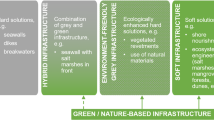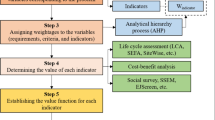Abstract
Riverbank erosion has become a global concern over the past few decades. Various mitigation measures have been employed globally to counter the same, but the use of sand filled geotextile bags (geobags) as revetment structures have evolved as a sustainable solution because of its low cost, eco friendly nature, ease of installation and technical efficiency. The use of geobags has been reported to reduce the cost of revetment structures by 40–60% as compared to conventional rigid material (such as rock riprap, gabion walls, etc.) because of its easy availability, which in turn considerably reduces transportation cost of heavy aggregates. The flexible nature of geobags allows them to ‘launch’ down the eroded slope when scouring occurs beneath the revetment structures. As a result, geobags have been found to be a viable and sustainable solution to protect toe scouring by protecting the slope and driving the scour away from the bank. Geobags when placed in multiple layers are reported to be more durable in the field, even if the top layer gets damaged. Geobags revetment structure is independent of any specific bond configuration but is dependent upon the friction mobilized between individual geobags due to overlapping. The optimal setup can be achieved by about 50% overlap of geobags. Laboratory investigations by different researchers have revealed that uplifting, turbulent bursting, overtopping, pulling out, internal sliding and toe scours are the different possible modes of failure of these geobags. This paper explores the design aspects of geobags and salient application areas, with an aim to explore the effectiveness of this sustainable technique of riverbank protection for possible field implementation.








Similar content being viewed by others
References
Dekaraja D, Mahanta R (2021) Riverbank erosion and migration inter-linkage: with special focus on Assam, India. Environ Syst Res. https://doi.org/10.1186/s40068-020-00214-0
Thompson A, Oberhagemann K, She Y (2020) Geobag stability for riverbank erosion protection structures: physical model study. Geotext Geomembr 48(1):110–119. https://doi.org/10.1016/j.geotexmem.2019.103526
Phukan A, Goswami R, Borah D, Nath A, Mahanta C (2012) River bank erosion and restoration in the Brahmaputra River in India. Clar Multidiscip Int J 1(1):1–7
Neitzert M, Berndtsson R (2012) Landscape and urban planning for the resilience of the built environment—a review of the scholarly literature. Landscape Research Record, 2014(3). http://lrlr.landscapeonline.de/Articles/lrlr-2014-3/refs.html#ref-Neitzert2012
National Disaster Management Authority (NDMA) (2014) Information on floods. http://www.ndma.gov.in/en/media-public-awareness/disaster/naturaldisaster/
Internal Displacement Monitoring Centre (n.d.) Displacement data. https://www.internal-displacement.org/database/displacement-data
Jafarnejad M, Franca MJ, Pfister M, Schleiss AJ (2019) Design of riverbank riprap using large, individually placed blocks. J Hydraul Eng 145(12):04019042
Yasuhara K, Recio-Molina J (2007) Geosynthetic-wrap around revetments for shore protection. Geotext Geomembr 25(4–5):221–232
Restall SJ, Jackson LA, Heerten G, Hornsey WP (2002) Case studies showing the growth and development of geotextile sand containers: an Australian perspective. Geotext Geomembr 20:3–4
Saathoff F, Oumeraci H, Restall S (2007) Australian and German experiences on the use of geotextile containers. Geotext Geomembr 25(4–5):251–263. https://doi.org/10.1016/j.geotexmem.2007.02.009
Oberhagemann K, Hossain MM (2011) Geotextile bag revetments for large rivers in Bangladesh. Geotext Geomembr 29(4):402–414. https://doi.org/10.1016/j.geotexmem.2010.12.003
TenCate (2018) TenCate Geosynthetics Asia
Patil RS, Patil VN, Nalawade PM, Kamble PN (2020) Application of geobags for control of soil erosion in Panchanganga River Basin Area: an eco-friendly defense. Int J Emerg Technol Innov Res 7(8):2216–2221
Sadik MS, Wahed S, Mohsina Muhit S (2011) Environmental impact of using sand filled geobag technology under water in river erosion protection of major rivers of Bangladesh
Korkut R, Martinez EJ, Morales R, Ettema R, Barkdoll B (2007) Geobag performance as scour countermeasure for bridge abutments. J Hydraul Eng 133(4):431–439
Tang R, Sheng T, Xiao C (2022) Anti-liquefaction performance of stacked sandbags: shaking table tests and numerical simulations. KSCE J Civ Eng 26(11):4444–4457. https://doi.org/10.1007/s12205-022-1810-x
Mori E, D’Eliso C, Aminti PL (2008) Physical modelling on geotextile sand container used for submerged breakwater. In: proceedings of 2nd international conference on the application of physical modelling to port and coastal protection, Coastlab08, Bari, Italy
Jamuna-Meghna River Erosion Mitigation Project (JMREM) (2006) Part B. Special Report 17, Geobag Revetments. Government of the People’s Republic of Bangladesh, Asian Development Bank, and Bangladesh Water Development Board
National Hydraulic Research Center (NHC) (2006) Jamuna-Meghna river erosion mitigation project part B. Special report 11, Physical model study (Vancouver, Canada), Final Report. Government of the People’s Republic of Bangladesh, Asian Development Bank, and Bangladesh Water Development Board
Mudiyanselage DTBDD (2013) Experimental and numerical modelling of the hydraulic stability of geotextile sand containers for coastal protection
PIANC (Permanent International Association of Navigation Congresses) (2011) The application of geosynthetics in waterfront areas. PIANC Secretariat General (MarCom report 113)
Gadd PE (1988) Sand bag slope protection: design, construction, and performance. Arctic coastal processes and slope protection design. ASCE, pp 145–165
Bezuijen A, De Groot MB, Breteler MK, Berendsen E (2004) Placing accuracy and stability of geocontainers. In: proceedings of EuroGeo
US Army Corps of Engineers (USACE) (1991) Hydraulic design of flood control channels, engineer manual, Washington
Neill C, Mannerstrom M, Azad AK (2008) Model tests on geobags for erosion protection. In: proceedings of the international conference on scour and erosion, Tokyo, Japan, pp 5–7
National Hydraulic Research Center (NHC) (2010) Padma multipurpose bridge design project RT23 Geobag flume model study. Prepared for Maunsell/AECOM and Bangladesh Bridge Authority
White K (2022) Physical study of geobag stability for erosion protection applications in rivers. Master’s thesis, University of Alberta, Department of Civil and Environmental Engineering. https://doi.org/10.7939/r3-hckb-y519
Dassanayake DT, Oumeraci H (2012) Engineering properties of geotextile sand containers and their effect on hydraulic stability and damage development of low-crested/submerged structures. Int J Ocean Climate Syst 3(3):135–150
Oberhagemann K, Stevens MA, Haque SMS, Faisal MA (2006) Geobags for riverbank protection. In: ICSE-3rd international conference on scour and erosion, pp 1–3
Akter A, Wright G, Crapper M, Pender G (2009) Failure mechanism in geobag structure. In: proceedings of the 4th IASME/WSEAS international conference on water resources, hydraulics & hydrology
Recio J, Oumeraci H (2008) Hydraulic permeability of structures made of geotextile sand containers: laboratory tests and conceptual model. Geotext Geomembr 26(6):473–487. https://doi.org/10.1016/j.geotexmem.2008.05.006
Zhu L, Wang J, Cheng N-S, Ying Q, Zhang D (2004) Settling distance and incipient motion of sandbags in open channel flows. J Waterw Port Coast Ocean Eng 130(2):98–103
Fedinger H (2004) Special Report 23: geotechnical report. Prepared for Jamuna Meghna River erosion mitigation project. Bangladesh Water Development Board. 2006
Fedinger H (2006) Special Report 22: geotechnical working paper. Prepared for Jamuna-Meghna River erosion mitigation project. Bangladesh Water Development Board
Zellweger H (2007) Geotextile bags for river erosion control in bangladesh. Swiss Federal Institute of Technology, Zürich
Recio J, Oumeraci H (2009) Process-based stability formulae for coastal structures made of geotextile sand containers. Coast Eng 56(5–6):632–658. https://doi.org/10.1016/j.coastaleng.2009.01.011
Khajenoori L, Wright G, Crapper M (2021) Laboratory investigation of geobag revetment performance in rivers. Geosciences (Switzerland). https://doi.org/10.3390/geosciences11080304
Antón AI, De La Peña JM, Almazán JL, Lechuga A (2016) Appropriate locations for geotextile bag revetments: an analysis. J Coastal Res 32(6):1456–1463. https://doi.org/10.2112/JCOASTRES-D-15-00155.1
Pilarczyk K (2000) Geosynthetics and geosystems in hydraulic and coastal engineering. CRC Press
White K, She Y, Zhang W (2022) A comparison of shear stress estimation methods for a single geobag on a rough bed. Geotext Geomembr 50(6):1230–1243. https://doi.org/10.1016/j.geotexmem.2022.09.001
Elkholy M, Chaudhry MH (2011) Drag and added-mass coefficients of large sandbags. J Hydraul Eng 137(11):1441–1451. https://doi.org/10.1061/(asce)hy.1943-7900.0000418
Gogus M, Defne Z (2005) Effect of shape on incipient motion of large solitary particles. J Hydraul Eng 131(1):38–45
Akter A, Pender G, Wright G, Crapper M (2013) Performance of a geobag revetment. I: quasi-physical modeling. J Hydraul Eng 139(8):865–876. https://doi.org/10.1061/(asce)hy.1943-7900.0000735
Akter A, Crapper M, Pender G, Wright G, Wong WS (2012) Modelling the failure modes in geobag revetments. Water Sci Technol 65(3):418–425. https://doi.org/10.2166/wst.2012.812
Akter A (2011) Modelling of geobags for river bank protection (PhD Thesis). Heriot-Watt University, School of the Built Environment
Akter A (2016) A study on the hydraulic forces on geobag protected revetments. J Civ Eng (IEB) 44(1):53
Oumeraci H (2004) Sustainable coastal flood defences: scientific and modelling challenges towards an integrated risk-based design concept. In: proceeding first IMA international conference on flood risk assessment, IMA-institute of mathematics and its applications, session, pp 9–24
US Army Corps of Engineers (USACE) (2004) Sandbagging techniques. Northwestern Division, USA
NDSU, DOE US (2010) Sandbagging for flood protection. Extension engineer. AE-626 (Revised). www.ag.ndsu.edu. Accessed 12 Dec 2010
Ministry of Water Resources, River Development & Ganga Rejuvenation, Government of India, Ganga Flood Control Commission (2016) Guidelines for use of geotextiles/geotextile bag / geotextile tubes in construction of flood management work, Patna
Scottish Natural Heritage (2000) http://www.snh.org.uk/. Accessed 10 Nov 2010
BSI (1995) Testing aggregates. Methods for determination of density British Standards Institution, CAMA (2010) Coastal Area Management Act
NSW (2010) Minister’s Requirements under the Coastal Protection Act 1979. Department of Environment, Climate Change and Water, NSW. www.environment.nsw.gov.au. Accessed 10 Aug 2010
GEOFABRICS (2018) Coastal and Waterways Smarter Solutions, Geofabrics Australasia Pty Ltd.: https://www.geofabrics.co
Funding
There is no funding associated with this work.
Author information
Authors and Affiliations
Corresponding author
Ethics declarations
Conflict of interest
The authors declare that they have no conflict of interest.
Additional information
Publisher's Note
Springer Nature remains neutral with regard to jurisdictional claims in published maps and institutional affiliations.
Rights and permissions
Springer Nature or its licensor (e.g. a society or other partner) holds exclusive rights to this article under a publishing agreement with the author(s) or other rightsholder(s); author self-archiving of the accepted manuscript version of this article is solely governed by the terms of such publishing agreement and applicable law.
About this article
Cite this article
Guin, S., Bhattacherjee, D. Applicability of Geobags as a Sustainable Riverbank Protection Measure. Indian Geotech J (2024). https://doi.org/10.1007/s40098-024-00895-9
Received:
Accepted:
Published:
DOI: https://doi.org/10.1007/s40098-024-00895-9




